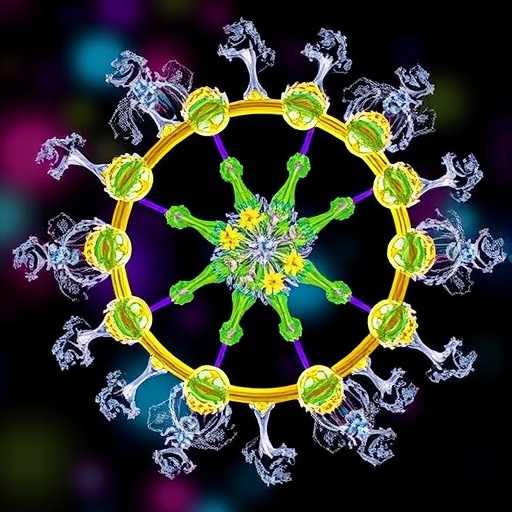In a groundbreaking study, researchers have unveiled a novel technique that enhances the immunogenic potential of nanoparticles by facilitating the non-covalent assembly of multiple epitopes onto a single nanoparticle. This approach opens new avenues for vaccine development, particularly in eliciting robust immune responses against a variety of pathogens. The key to this advancement lies in the intricate manipulation of molecular interactions to smartly position multiple epitopes, which are the small fragments of proteins that are recognized by the immune system, on a single nanoparticle platform.
The study, conducted by Kealy and Good-Jacobson, surfaces amidst a growing interdisciplinary effort to harness the unique properties of nanoparticles in biomedical applications. Historically, conventional vaccine approaches have relied heavily on singular antigens to provoke immune responses; however, the multiplicity of pathogens and their variants necessitates more dynamic solutions. By leveraging the non-covalent assembly method, the researchers have successfully demonstrated a sophisticated technique that overcomes the limitations of traditional covalent linkages, which can often hinder the effectiveness and flexibility of vaccine formulations.
Central to their findings is the careful selection of epitopes that can be loaded onto the nanoparticle surface. This involves understanding the physicochemical properties of both the epitopes and the nanoparticles used. The researchers meticulously detailed their criteria for selecting epitopes, considering factors such as solubility, charge, and size, which ultimately influence how well these molecules associate with each other and interact with the immune system.
Moreover, the study emphasizes the role of nanoparticle characteristics, such as size, shape, and surface chemistry in achieving optimal epitope presentation. The authors highlight that the right nanoparticle can significantly enhance the uptake of epitopes by antigen-presenting cells, leading to a more efficient activation of T and B cells, which are central players in immune responses. Therefore, by modifying just a few parameters, the researchers managed to create a versatile platform capable of targeting a range of pathogens, from viral to bacterial agents.
The immune system’s complexity poses a significant challenge for vaccine developers. To tailor vaccines that can effectively stimulate a robust immune response, the researchers investigated how various combinations of epitopes interacted with the immune system. This approach enables the fine-tuning of immune responses, allowing the assembly of epitopes that could either enhance activation or encourage tolerance, ultimately guiding the immune system’s memory formation and subsequent responses to reinfection.
One of the most compelling aspects of this research centers on the use of nanoparticle carriers for sequential epitope presentation. The authors demonstrate that by varying the timing and delivery of different epitopes, they can manipulate immune outcomes. This sequential delivery can be pivotal in generating long-lasting immunity and in combating pathogens that can mutate, such as those responsible for certain viral diseases.
Further investigations revealed that the method could be potentially expanded to create personalized vaccine strategies. By assembling highly specific epitopes that reflect a patient’s unique immunological profile, it may be possible to design tailored therapies that enhance vaccine efficacy. This could revolutionize our approach to vaccines, making treatments more effective against increasingly prevalent and resistant strains of infectious diseases.
In the context of infectious diseases, the enhancements offered by this nanoparticle approach could reshape public health responses. The ability to combine multiple targeted antigens into a single formulation means that vaccines could be developed more rapidly, addressing emerging public health threats with agility. The authors propose that the flexibility of this method could facilitate faster vaccine development pathways, ultimately saving lives in critical situations.
Notably, the non-covalent nature of the assembly process provides additional benefits concerning regulatory approval and manufacturing scalability. Unlike conventional approaches that require extensive modification processes, the simplicity and efficiency of this new method streamline production and reduce potential costs. As these advances unfold, the implications for community health could be profound, particularly in under-resourced settings where rapid response capabilities are crucial.
As the world grapples with the challenges of vaccine accessibility and rapid development, this research shines a light on the hope that nanotechnology holds in modern medicine. The study makes a significant contribution not only to the field of vaccinology but also to the broader realm of immunotherapy, potentially providing new strategies to mitigate diseases ranging from cancer to autoimmune disorders.
In conclusion, the findings presented by Kealy and Good-Jacobson signify an exciting milestone in the ongoing journey toward effective vaccine development. By overcoming traditional hurdles associated with epitope display through ingenious nanoparticle design, the researchers set the stage for a new era of vaccinations that promise improved efficacy and broader protection against a myriad of diseases.
With the incorporation of multiple epitopes on a single nanoparticle platform, this technology not only enhances the immune response but also incurs a substantial leap in our ability to respond to disease outbreaks. As researchers continue to build on this promising work, the potential applications extend far beyond infectious disease vaccines, forging a path towards innovative therapeutic solutions in the landscape of medicine.
The advancement of this non-covalent assembly presents tantalizing opportunities for both academia and industry. It enables a collaborative convergence of biotechnology, materials science, and immunology, fostering interdisciplinary innovations that could redefine therapeutic interventions. As work on this technology progresses, the global scientific community watches with keen interest, eager to leverage these insights into concrete applications that can significantly impact public health.
In summation, this transformative research alludes to a future where the hurdles of vaccine development may soon be surmountable, enhanced by the dynamic capabilities offered by nanoparticle technology and the clever engineering of epitope assembly. Through concerted efforts and collaboration, the path forward appears clearer, promising an arsenal of vaccines designed to save lives and protect global health against ever-evolving threats.
Subject of Research: Non-covalent assembly of multiple epitopes onto a single nanoparticle
Article Title: Non-covalent assembly of multiple epitopes onto a single nanoparticle.
Article References:
Kealy, L.C., Good-Jacobson, K.L. Non-covalent assembly of multiple epitopes onto a single nanoparticle.
Nat. Biomed. Eng (2025). https://doi.org/10.1038/s41551-025-01530-5
Image Credits: AI Generated
DOI: 10.1038/s41551-025-01530-5
Keywords: nanoparticle technology, vaccine development, epitopes, immune response, immunotherapy, infectious diseases, non-covalent assembly.




